County Board Districts Likely to Change
Washtenaw County apportionment commission meeting (April 28, 2011): Two potential redistricting plans – one increasing the number of districts for the Washtenaw County board of commissioners from 11 to 12, another cutting the number to nine – were presented at a public meeting last Thursday. It’s another step toward completing the once-every-10-year redistricting process, based on changes in census data.

Washtenaw County prosecuting attorney Brian Mackie looks on as Julia Roberts hangs a map of Mackie's redistricting plan, which proposes nine districts for the county board of commissioners, instead of the current 11. (Photos by the writer.)
The plans were submitted by three members of the five-member apportionment commission. The 9-district plan was proposed by county prosecuting attorney Brian Mackie, a Democrat. It would reduce the number of Ann Arbor districts from four to three, and put two current commissioners – Republican Alicia Ping of District 3, who lives in Saline, and Democrat Wes Prater of District 4, a York Township resident – in the same district.
The 12-district plan – which creates a new district for Scio Township – was proposed by county clerk Larry Kestenbaum, a Democrat who chairs the apportionment commission, and Mark Boonstra, a commission member and chair of the Washtenaw Republican Party. In this plan, Ann Arbor would retain its four seats on the county board.
The apportionment commission discussed the plans but did not vote. Two additional meetings are scheduled: on Wednesday, May 4 at 5 p.m. and on Wednesday, May 11 at 5:30 p.m. Both meetings will be held in the lower-level conference room at 200 N. Main St., Ann Arbor. By law, the commission has until June 6 to approve a redistricting plan. Other commission members are county treasurer Catherine McClary, and the chair of the county Democratic Party, Cleveland Chandler.
About a dozen people attended Thursday’s meeting, and many of them spoke during the time allowed for public commentary. Kestenbaum began the meeting by noting that there was no American flag in the room, so they could skip the Pledge of Allegiance.
Public Commentary
Six people spoke during public commentary at the start of the meeting.
David Raaflaub of Ypsilanti introduced himself as an experienced litigator and a student of gerrymandering for the past 25 years. [He was also a candidate in 2010 for the Washtenaw County board of commissioners in District 6.] He said if he finds that redistricting results in his vote having less value, he’s willing to go to federal court and challenge the commission’s decision as unconstitutional. Raaflaub said he had no doubt that the commission would decide the districts in favor of the Democratic Party. [Of the five-member apportionment commission, four are Democrats.] It’s a “big scoop of power” that they wield, he said, and he regrets that Democrats have ruined so many cities in Michigan. Raaflaub concluded by saying he was there with “not friendly motives” toward what he views as unconstitutional.
Ahmar Iqbal of Ann Arbor spoke on behalf of the Asian Pacific Islander American Vote-Michigan – he’s a board member of that nonprofit organization. He reminded the commission that APIA had sent a letter to them about the issue of a growing Asian population in the county, especially in Ann Arbor. In Washtenaw, Asians, native Hawaiians and Pacific Islanders account for 7.9% of the population, according to U.S. census data. In Ann Arbor, that group accounts for 14.39% of the total population. He ask that the commission, as they consider redistricting plans, try to keep this community together.
Bill Bigler of Ann Arbor asked whether the public would have the chance to comment after the commission presented and discussed the plans. Kestenbaum said there would be another opportunity for public commentary at the end of the meeting.

Cleveland Chandler, left, talks with county commissioner Yousef Rabhi before the start of the April 28 apportionment commission meeting. Chandler, an apportionment commission member, is chair of the Washtenaw County Democratic Party.
Christina Montague, a former Washtenaw County commissioner from Ann Arbor, talked about the importance of everyone in the community having a voice, and having their vote count. It’s important that minorities in this county have the opportunity to be elected to public office, she said, so that their voice aren’t just heard – they’re also able to make a contribution.
Yousef Rabhi, a current county commissioner representing District 11 in Ann Arbor, urged the apportionment commission to not to divide the student populations, if possible. He noted that students were split among different wards in the city of Ann Arbor – South Quad voted in one ward, East Quad in another – and that wasn’t the best situation. It appeared that the proposed 12-district plan accomplishes the goal of keeping students in the same district, he said.
Eric Sheie Scheie of Ann Arbor told the commission that he preferred the 12-district plan, which didn’t seem to split districts as much. He said he didn’t support going down to nine districts.
Public Commentary: Response from Commissioners
Kestenbaum said he’s a long-time admirer of Raaflaub. But as far as concerns over electing commissioners by plurality from single-member districts, he said, that’s not within the province of the apportionment commission. Their charge is to create single-member districts. Given that this style of governance is long-standing in the United States, Kestenbaum questioned whether a constitutional challenge could be successful. If the Supreme Court ruled that it abridged the rights of minority voters in the district, it would be a huge change, he said. It wasn’t that he would necessarily be opposed to a change, he added, but it would be unlikely.
Turning to Iqbal’s remarks, Kestenbaum said he wasn’t sure what specific suggestions Iqbal was offering. The Asian population is large, but it is scattered throughout the city, he said – he didn’t see it as a community that was concentrated and at risk of being broken up by redistricting. That said, Kestenbaum added that he was open to suggestions, but the implications for the apportionment commission’s work weren’t clear to him. He noted that he had worked on Eugene Kang’s campaign for city council several years ago. [Kang lost that 2005 Democratic primary race against Stephen Rapundalo, 480-575, but went on later to work in President Barack Obama's administration.]
Cleveland Chandler said it was important to also respond to Montague’s comments. The commission needs to redraw the maps according to the law, he said, but they also need to ensure that minority representation is maintained. He thought the 12-district plan did that.
Nine-District Plan
Brian Mackie began his presentation by thanking Julia Roberts, a University of Michigan graduate student who’s been hired as support staff for this redistricting process. He said she’d been a tremendous help, and indicated that she didn’t care about the politics or individual players in this process, which was a good thing.
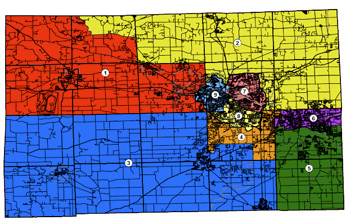
This map shows the proposed 9-district map for the Washtenaw County board of commissioners. (Links to larger image.)
Mackie’s plan proposes nine districts. Major changes include the number of districts in Ann Arbor decreasing from four to three. The plan would also put two current commissioners – Republican Alicia Ping of District 3, who lives in Saline, and Democrat Wes Prater of District 4, a York Township resident – in the same district. [.pdf file of nine-district map]
It’s not possible to completely satisfy each aspect of the statute, Mackie said, but population is the most important consideration – that seems to be true if you look at the appellate court cases on this issue.
Mackie highlighted several aspects of his plan. He noted that districts on the west side of the county were large geographically, but that’s inevitable because of the lower population in that area.
Because Ann Arbor’s population is roughly a third of the total county population, the number of total districts needs to be divisible by three, Mackie noted. In a nine-district plan, that means Ann Arbor is divided into three districts.
Scio Township is currently represented by six different commissioners – residents there have a right to complain, Mackie said. He pointed out that former county commissioner Dick DeLong, who’s now a Scio Township trustee, had urged them to keep the township in one district, and not divide it. Mackie said it wouldn’t be completely possible, since there are still many township islands within the city of Ann Arbor – those residents would be represented by Ann Arbor commissioners. But the township can be less divided than it is now.
Mackie said that Ypsilanti Township, because of its large population, would need to be divided under any plan, unless there were far fewer districts.
He also noted that he’d been concerned about the 12-district plan because it split Pittsfield Township in a way that seemed to target one current commissioner, putting her in another district. [He was referring to commissioner Kristin Judge, who represents District 7. Her district currently covers the entire township. Later in the meeting, Mark Boonstra said the 12-district plan doesn't target anyone – all current commissioners would remain in separate districts.]
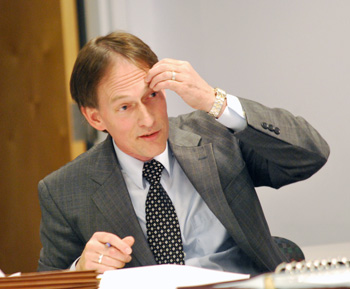
Mark Boonstra, chair of the Washtenaw County Republican Committee and a member of the county apportionment commission.
Though there can be an 11.9% variance from the county’s “ideal” population in any district, Mackie said that shouldn’t be the target. Rather, they should work for a variance that’s as close to zero as possible. [The “ideal” district population is calculated by dividing the county population by the number of districts. Washtenaw County’s population is 344,791, based on 2010 census data. In Mackie's plan, seven districts have a variance of less than 3.5%. Two districts have much higher variances – though still within the legal limit – going over the ideal by 11.4% in one case (District 3), and under by 10.46% in another (District 4).]
Mackie said he has a great deal of respect for commissioners. Their preferences for the number of districts have varied, he said, from a low of five to a high of 21. But several commissioners – including McClary, a former county commissioner – have indicated that the current 11-district commission functioned better than the 15-district commission that had been in place for 10 years prior to 2001, so he was opting for fewer districts.
In commenting on Mackie’s plan, Mark Boonstra said the 12-district plan – which he and Larry Kestenbaum proposed – doesn’t target any individual commissioner. He also noted that although the nine-district plan leaves Scio Township largely intact, in splits Dexter Township.
Roberts said she thought it was possible to move all of Dexter Township into the same district. It would increase the population variance, but she believed it would still be within the legal limit.
Twelve-District Plan
Mark Boonstra introduced the 12-district plan, describing it as a variation of one that Larry Kestenbaum had drafted. He highlighted some of the changes he’d made from Kestenbaum’s original, such as eliminating a split of Lodi Township and in general improving the variance percentages. [.pdf map of 12-district plan]
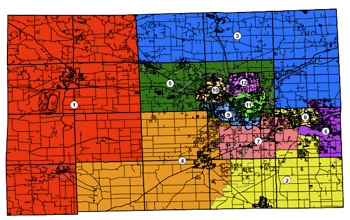
The map shows the proposed 12-district Washtenaw County board of commissioners. (Links to larger image.)
Kestenbaum pointed out that in the western side of the county, none of the townships are split. Ypsilanti Township is split into multiple districts, but the only way it could stay whole would be if there were just five districts in the county, he said.
He noted that three townships – Ann Arbor, Scio and Pittsfield – have islands in the city of Ann Arbor, so there’s no way to avoid having parts of those townships in different districts.
The district with the highest variance – 4.67% – is the one covering Ypsilanti, Kestenbaum said. Another district, which includes Augusta Township and parts of Ypsilanti and York townships, has a variance of 4.08%. The variances could be lowered by splitting precincts, he said. Kestenbaum noted that Ypsilanti Township’s precincts will likely be redrawn soon as part of the state and Congressional redistricting process, so it’s not as important to keep those precinct boundaries sacred.
This plan proposes four districts in Ann Arbor, divided primarily along major roadways. Kestenbaum noted that there are some split districts, but he said that the precincts in the city will also be redrawn for state and Congressional redistricting.
Kestenbaum said that only one current commissioner would be affected by this plan, and she had told him that she wasn’t planning to run for re-election. [Kestenbaum was referring to Barbara Bergman, a Democrat representing District 8 in Ann Arbor, who has made that statement several times in public as well.]
Kestenbaum also noted that the numbering on the proposed plan would be changed – the new district, in Scio Township, would be District 12.
In commenting on the plans, Cleveland Chandler said he’s leaning toward the one with 12 districts. It would be a better fit for the county, he said, adding that he’d like to tweak some aspects of it – for example, changing some boundaries in Ypsilanti Township.
Next Steps
One more meeting – on Wednesday, May 4 – had already been scheduled. That meeting starts at 5 p.m. at the lower-level conference room of the county administration building, 200 N. Main St. in Ann Arbor.
The commissioners discussed whether to hold another meeting beyond that, and ultimately decided to schedule one on Wednesday, May 11 starting at 5:30 p.m. in the same location.
Julia Roberts noted that her last day working as support staff for the apportionment commission is May 4. She noted that the commission has until June 6 to select a plan. So far, only the two plans discussed at Wednesday’s meeting have been submitted – Roberts said she has not received any plans from the general public. All commissioners offered their thanks for her work.
Public Commentary: Part II
The meeting concluded with additional public commentary.
Bill Bigler said he’d support a plan that kept the districts as close as possible to the current number, so he preferred the 12-district proposal.
Eric Sheie said that after hearing the discussion, he was more convinced than ever that the 12-district plan would be better. Nine districts makes him nervous, he said.
Christina Montague also expressed preference for the 12-district plan, saying it seemed more responsive to the community and addressed the needs of urban and rural areas.

From left: Washtenaw County prosecuting attorney Brian Mackie, county treasurer Catherine McClary, and Cleveland Chandler, chair of the Washtenaw County Democratic Party. All three are members of the county apportionment commission.
Stuart Berry, an Ann Arbor resident, asked what it would cost taxpayers to increase the number of districts to 12.
Kestenbaum replied that it depends on the salary that’s set by commissioners for themselves – now, commissioners are paid $15,500 annually. [Officers of the board are paid somewhat higher salaries.] He said there’s been talk among current commissioners that if the board is expanded, they’d simply take the current total spent on salaries and divide it by 12, rather than 11, to set the new salary. Berry expressed skepticism that this would actually happen.
Catherine McClary, looking at the county’s 2011 budget, reported that the line item for commissioners’ salaries is $261,652. The total budget for commissioners this year – including salaries, benefits, mileage, and travel allowance – is $512,473.
Berry urged the apportionment commission to control costs as much as possible, and not increase the number of districts.
[For additional information about the redistricting process, see Chronicle coverage: "Public Gives Input on County Redistricting," "Washtenaw Redistricting Work Begins" and "County Clerk Outlines Redistricting Process"]




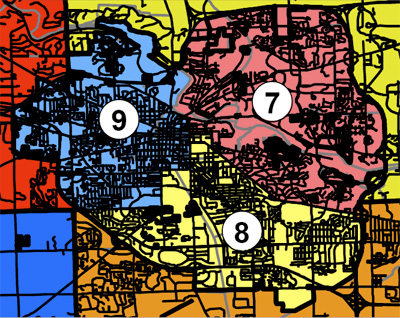
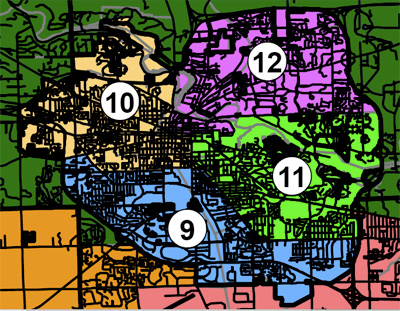
Perhaps the headline should read, “County Board Districts likely to change – but not very much”. The 12-member plan seems designed to retain districts for all continuing commissioners, which means that it will likely be chosen. The big question was Ypsilanti City, represented by Ronnie Peterson. Peterson is the “minority” for whom concern is being expressed; since that city lost population, the only way to maintain his district was to make more districts, which has been accomplished.
I still think it is crazy to have an even number of districts, but perhaps all votes will be unanimous.
“It appeared that the proposed 12-district plan accomplishes the goal of keeping students in the same district, [Rabhi] said.”
Should this read “keeping students in the same [separate] districts?” Both plans use State Street as a boundary, separating the student neighborhoods, including South Quad and East Quad, as noted.
Looking at the plans from the perspective of a Scio resident, the 12 district map seems more appropriate. As a township on the urban fringe, we have more common interests with Ann Arbor Township (and the City) than with the very rural west of the county, Lyndon and Sylvan townships. Of course, there are a lot of Scio residents who feel the exact opposite–there’s a pretty strong east-west divide here.
I’m not sure incorporating the two little chunks of Pittsfield into the district makes a lot of sense though.